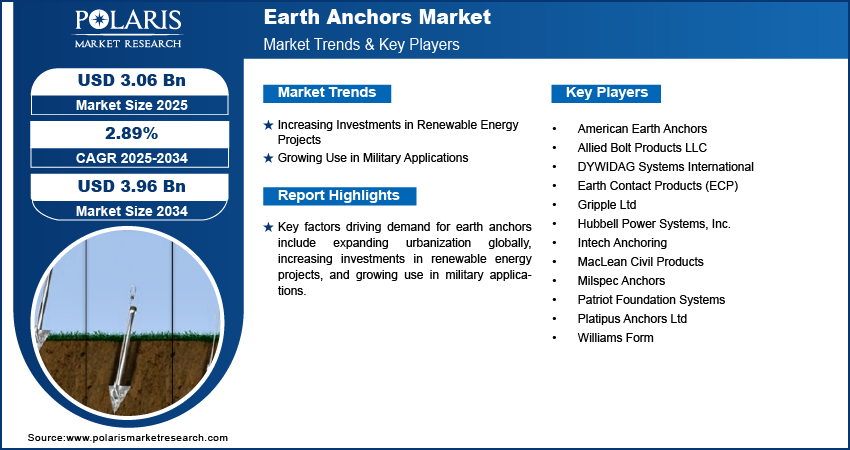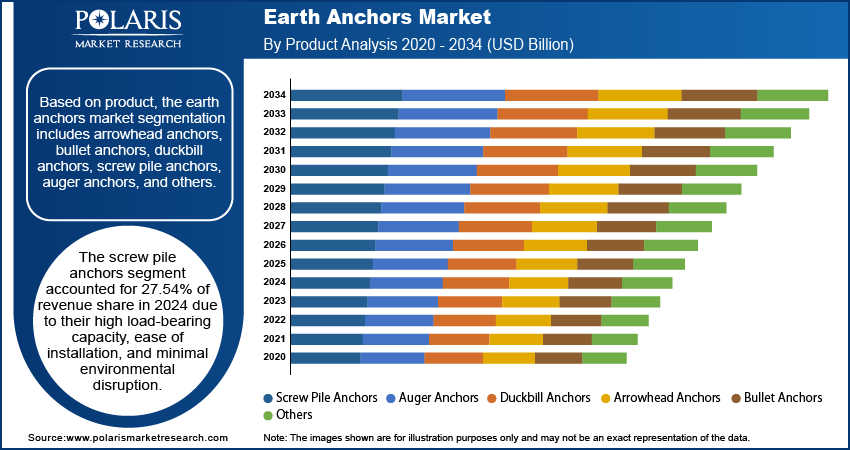
Earth Anchors Market Size, Share, Trends, & Industry Analysis Report
By Product (Arrowhead Anchors, Bullet Anchors, Duckbill Anchors, Screw Pile Anchors, Auger Anchors, Other), By Application, By Region – Market Forecast, 2025–2034
- Published Date:Aug-2025
- Pages: 129
- Format: PDF
- Report ID: PM6236
- Base Year: 2024
- Historical Data: 2020-2023
Overview
The global earth anchors market size was valued at USD 2.98 billion in 2024, growing at a CAGR of 2.89% from 2025–2034. Key factors driving demand for earth anchors include expanding urbanization globally, increasing investments in renewable energy projects, and growing use in military applications.
Key Insights
- The screw pile anchors segment accounted for 27.54% of revenue share in 2024 due to their ease of installation and high load-bearing capacity.
- The commercial segment held 77.13% of revenue share in 2024 due to the increasing investments in the development of roads, bridges, and renewable energy facilities.
- Asia Pacific accounted for 39.15% of global revenue share of the global market in 2024, owing to rapid urbanization and infrastructure development.
- China held the largest revenue share in the Asia Pacific earth anchors market in 2024, due to growing urban redevelopment programs.
- The industry in Europe is projected to grow at the fastest pace in the coming years, owing to expanding construction activities.
Industry Dynamics
- The increasing investments in renewable energy projects is driving the demand for earth anchors, as they are widely used in solar farms, wind turbines, and hydropower installations to provide stable foundations
- The growing use of earth anchors in military applications is fueling the market growth as military engineers use them to secure temporary bridges and command posts.
- The expanding marine industry worldwide is creating a lucrative market opportunity.
- The strong dependence on soil conditions hinders the demand for earth anchors.
Market Statistics
- 2024 Market Size: USD 2.98 Billion
- 2034 Projected Market Size: USD 3.96 Billion
- CAGR (2025–2034): 2.89%
- Asia Pacific: Largest Market Share

AI Impact on Earth Anchors Market
- There is a rising focus on research to explore AI-driven modeling methods. For instance, a stacking machine learning (ML) model estimates the pullout capacity of small earth anchors (e.g., those used in tents) using cone penetration data. These models outperform traditional empirical formulas by achieving rapid and more accurate predictions
- Drones and edge-AI systems are used for autonomous visual inspections to detect various issues such as corrosion, cracks, or material fatigue.
- Automated AI-based drilling and grouting tools are expected to enhance precision while minimizing worker exposure to hazardous sites in the coming years.
Earth anchors, also known as ground anchors or mechanical anchors, are devices designed to transfer tensile loads to the ground. They are used to provide stability and support in various civil, geotechnical, and structural applications. These anchors consist of a rod, cable, or shaft connected to a load-bearing plate or helix that is driven, screwed, or embedded into the ground. They generate holding capacity through soil resistance, friction, or mechanical interlock, depending on the type and soil conditions.
The usage of earth anchors spans a wide range of applications. They are commonly used to stabilize retaining walls, embankments, slopes, and foundation systems in construction and infrastructure projects. In the utility and telecommunication sectors, earth anchors secure utility poles, transmission towers, and guyed masts. Additionally, they are widely used in marine applications to anchor docks, pontoons, and pipelines. Earth anchors are also used in residential and commercial projects to secure modular structures, fencing, sheds, and even solar panel installations.
The global earth anchors market demand is driven by expanding urbanization globally. World Economic Forum, in its report, stated that the share of the world’s population living in cities is expected to rise to 80% by 2050, from 55% in 2022. This is driving developers and engineers to use earth anchors to stabilize slopes, secure excavations, and prevent soil erosion in densely populated areas where space constraints demand efficient land use. The rise in urbanization is also fueling underground construction, such as parking garages and subway systems, which is driving demand for earth anchors as they provide critical support to prevent collapses. Additionally, urban expansion into challenging terrains, such as hillsides or flood-prone zones, requires earth anchors to reinforce structures against natural forces, ensuring safety and longevity in rapidly developing urban landscapes.
Drivers & Opportunities
Increasing Investments in Renewable Energy Projects: Earth anchors are widely used in solar farms, wind turbines, and small hydropower installations to provide stable foundations to withstand environmental forces. Solar panel arrangements use earth anchors to secure mounting systems, especially in loose or uneven terrain, while wind turbine foundations rely on them to resist uplift and lateral loads from high winds. Hydropower projects often install earth anchors to reinforce dams, retaining walls, and embankments, ensuring long-term stability. Therefore, as governments and private sectors expand renewable energy infrastructure through heavy investment, the need for reliable anchoring solutions grows, particularly in remote or challenging landscapes where traditional foundations may fail. The International Energy Agency, in its report, stated that USD 2 trillion was invested in clean energy technologies and infrastructure across the globe in 2024.
Growing Use in Military Applications: Military engineers are using earth anchors to secure temporary bridges, command posts, and communication towers, ensuring stability in harsh or unstable environments. They are also using earth anchors to build defensive structures, such as bunkers and barriers, to withstand blasts or heavy loads. Special operations further require portable anchoring systems for securing equipment in remote or hostile locations, where traditional foundations are impractical. Therefore, as modern warfare increasingly emphasizes mobility and adaptability, militaries worldwide are investing in advanced earth anchor solutions, driving market growth.

Segmental Insights
Product Analysis
Based on product, the segmentation includes arrowhead anchors, bullet anchors, duckbill anchors, screw pile anchors, auger anchors, and others. The screw pile anchors segment accounted for 27.54% of revenue share in 2024 due to their high load-bearing capacity, ease of installation, and minimal environmental disruption, making them the preferred choice for construction, utility, and infrastructure projects. Contractors and engineers increasingly adopted these anchors owing to their ability to provide immediate load-bearing capabilities without the need for concrete curing time. Additionally, growing infrastructure investments in both developed and developing regions, especially for solar farms, telecom towers, and oil and gas pipelines, further boosted the demand for screw pile variants.
The auger anchors segment is projected to register the highest CAGR from 2025 to 2034, owing to their expanding use in temporary and semi-permanent applications across construction, marine, and disaster relief sectors. The strong holding strength in loose or sandy soils and their reusability are making them ideal for rapidly deployed structures and temporary installations. Furthermore, the increasing frequency of extreme weather events and natural disasters is driving the need for fast, reliable anchoring solutions, leading to segment growth. Advances in auger anchor design, offering improved torque resistance and installation efficiency, are expected to accelerate their adoption across a broader range of construction, marine, and disaster relief sectors.
Application Analysis
In terms of application, the segmentation includes residential and commercial. The commercial segment held 77.13% of revenue share in 2024 due to the rapid expansion of infrastructure development projects, including roads, bridges, utility installations, and renewable energy facilities. Commercial projects heavily used earth anchoring solutions to ensure structural stability in varied soil and environmental conditions. Industries such as telecommunications, oil and gas, and construction increasingly relied on anchoring systems for securing towers, pipelines, retaining walls, and slope stabilization. Additionally, governments across North America, Asia Pacific, and the Middle East significantly increased infrastructure budgets, further driving the demand for anchoring systems in commercial projects.
The residential segment is projected to grow at a rapid pace during the forecast period, owing to rising global demand for affordable housing, modular construction, and home renovation projects. Homeowners and builders prefer anchoring systems for securing retaining walls, decks, fences, and foundation repairs due to their low cost, quick installation, and minimal excavation requirements. Increasing awareness about soil erosion control, especially in flood-prone and hilly residential areas, has also prompted the adoption of reliable anchoring solutions. Furthermore, technological advancements in lightweight and corrosion-resistant materials are making these systems more accessible and practical for residential use, supporting the segment’s continued growth.

Regional Analysis
The Asia Pacific earth anchors market accounted for 39.15% of global revenue share in 2024. This dominance is attributed to rapid urbanization, infrastructure development, and increasing construction activities. United Nations Human Settlements Programme, in its report, stated that the urban population in Asia is expected to grow by 50% by 2050. Countries such as India, Japan, and Australia invested heavily in transportation networks, renewable energy projects, and residential/commercial buildings, which propelled the need for earth anchors. Additionally, the growing need for slope stabilization and soil retention in hilly and flood-prone areas further boosted demand. Government initiatives promoting sustainable construction and disaster-resilient infrastructure also contributed to the rising adoption of earth anchors in the region.
China Earth Anchors Market Insights
China held the largest revenue share in the Asia Pacific earth anchors landscape in 2024, due to massive infrastructure projects under initiatives such as the Belt and Road Initiative (BRI) and urban redevelopment programs. The construction of bridges, tunnels, and high-rise buildings in seismic zones necessitated robust anchoring solutions. Moreover, China’s focus on renewable energy, particularly offshore wind farms, fueled the demand for earth anchors for foundation stability. The government’s emphasis on improving construction safety standards and preventing landslides in mountainous regions further propelled demand.
North America Earth Anchors Market Trends
The market in North America is projected to hold a substantial revenue share in 2034 due to the increasing investments in oil & gas pipelines, telecommunication towers, and renewable and clean energy installations. According to the International Energy Agency, investments in clean energy in the U.S. increased to USD 300 billion in 2024, 1.6 times the 2020 level. The U.S. and Canada are also focusing on upgrading aging infrastructure, including bridges and highways, which require anchoring systems for reinforcement. Additionally, the rise in extreme weather events in North America is leading to greater adoption of earth anchors for erosion control and flood prevention. The growing popularity of modular and prefabricated construction methods is also contributing to market growth.
U.S. Earth Anchors Market Overview
The demand for earth anchors in the U.S. is being driven by large-scale construction projects, military applications, and the expansion of utility infrastructure. The booming solar and wind energy sectors in the country rely on earth anchors for securing panel mounts and turbine foundations. Furthermore, the U.S. government’s focus on disaster resilience, particularly in hurricane and earthquake-prone regions, is increasing the use of earth anchors in retaining walls and foundation systems. The rise in DIY home improvement projects is also spurring the demand for lightweight anchoring solutions in the U.S.
Europe Earth Anchors Market
The industry in Europe is projected to grow at the fastest pace in the coming years, owing to stringent construction regulations and sustainability goals. Countries such as Germany, France, and the UK are investing in green building projects, underground construction, and offshore wind energy, where earth anchors are essential for stability. The need for retrofitting old structures to meet modern safety standards is further boosting market growth. Additionally, Europe’s focus on flood defense systems, particularly in the Netherlands and coastal regions, propels the adoption of earth anchors for soil reinforcement and erosion control.

Key Players & Competitive Analysis
The earth anchors market is highly competitive, with key players such as American Earth Anchors, Hubbell Power Systems, and DYWIDAG Systems International leading the industry through advanced engineering and durable solutions. These companies specialize in high-load applications for construction, utilities, and infrastructure projects. Allied Bolt Products and Milspec Anchors focus on rugged, corrosion-resistant designs, catering to military and heavy-duty industrial use. Meanwhile, Earth Contact Products (ECP) and Patriot Foundation Systems dominate the residential and commercial sectors with cost-effective helical and plate anchors. Gripple Ltd and Platipus Anchors Ltd bring innovation with lightweight, easy-to-install systems for soil stabilization and landscaping. Niche players such as Intech Anchoring and MacLean Civil Products emphasize customized solutions for challenging terrains. Competition is driven by product durability, installation efficiency, and compliance with environmental and safety standards, pushing manufacturers to continuously innovate in materials and anchoring technologies. Mergers and strategic partnerships in the industry are increasingly common as companies expand their global reach.
A few major companies operating in the earth anchors industry include American Earth Anchors; Allied Bolt Products LLC; DYWIDAG Systems International; Earth Contact Products (ECP); Gripple Ltd; Hubbell Power Systems, Inc.; Intech Anchoring; MacLean Power Systems; Milspec Anchors; Minova; Patriot Foundation Systems; and Williams Form.
Key Players
- American Earth Anchors
- Allied Bolt Products LLC
- DYWIDAG Systems International
- Earth Contact Products (ECP)
- Gripple Ltd
- Hubbell Power Systems, Inc.
- Intech Anchoring
- MacLean Power Systems
- Milspec Anchors
- Minova
- Patriot Foundation Systems
- Williams Form
Earth Anchors Industry Developments
In March 2025, Minova announced the acquisition of Platipus Anchors, a company involved in the design and manufacture of earth anchoring systems, to strengthen its presence in Europe and North America.
Earth Anchors Market Segmentation
By Product Outlook (Revenue, USD Billion, 2020–2034)
- Arrowhead Anchors
- Bullet Anchors
- Duckbill Anchors
- Screw Pile Anchors
- Auger Anchors
- Other
By Application Outlook (Revenue, USD Billion, 2020–2034)
- Residential
- Commercial
By Regional Outlook (Revenue, USD Billion, 2020–2034)
- North America
- U.S.
- Canada
- Europe
- Germany
- France
- UK
- Italy
- Spain
- Netherlands
- Russia
- Rest of Europe
- Asia Pacific
- China
- Japan
- India
- Malaysia
- South Korea
- Indonesia
- Australia
- Vietnam
- Rest of Asia Pacific
- Middle East & Africa
- Saudi Arabia
- UAE
- Israel
- South Africa
- Rest of Middle East & Africa
- Latin America
- Mexico
- Brazil
- Argentina
- Rest of Latin America
Earth Anchors Market Report Scope
|
Report Attributes |
Details |
|
Market Size in 2024 |
USD 2.98 Billion |
|
Market Size in 2025 |
USD 3.06 Billion |
|
Revenue Forecast by 2034 |
USD 3.96 Billion |
|
CAGR |
2.89% from 2025 to 2034 |
|
Base Year |
2024 |
|
Historical Data |
2020–2023 |
|
Forecast Period |
2025–2034 |
|
Quantitative Units |
Revenue in USD Billion and CAGR from 2025 to 2034 |
|
Report Coverage |
Revenue Forecast, Competitive Landscape, Growth Factors, and Industry Trends |
|
Segments Covered |
|
|
Regional Scope |
|
|
Competitive Landscape |
|
|
Report Format |
|
|
Customization |
Report customization as per your requirements with respect to countries, regions, and segmentation. |
FAQ's
The global market size was valued at USD 2.98 billion in 2024 and is projected to grow to USD 3.96 billion by 2034.
The global market is projected to register a CAGR of 2.89% during the forecast period.
Asia Pacific dominated the market in 2024.
A few of the key players in the market are American Earth Anchors; Allied Bolt Products LLC; DYWIDAG Systems International; Earth Contact Products (ECP); Gripple Ltd; Hubbell Power Systems, Inc.; Intech Anchoring; MacLean Civil Products; Milspec Anchors; Minova; Patriot Foundation Systems; and Williams Form.
The screw pile anchors segment dominated the market revenue share in 2024.
The residential segment is projected to witness the fastest growth during the forecast period.
